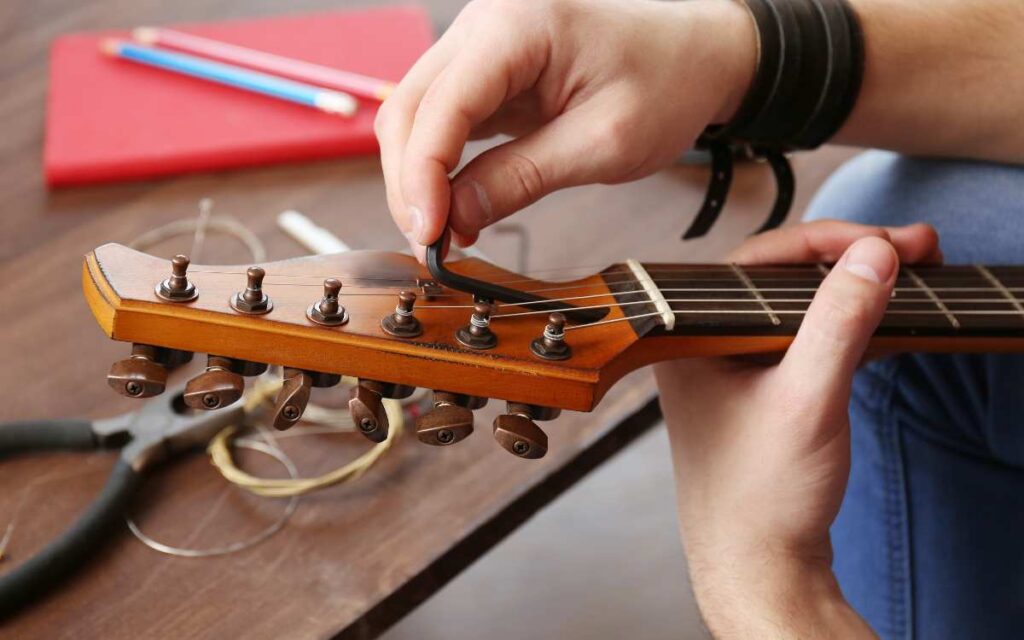We’ve all been there before—your fingers pressing those taut metal guitar strings down feel like they’re on fire during and after practice. The tendons in your hands refuse to bend in certain ways, and ordinary tasks become wincingly painful. As a 14-year-old novice, I still remember getting terrible blisters on my fingertips and nearly bleeding while trying to learn the D chord. While sore fingers are a common experience for aspiring guitarists, you can reduce and manage the pain with appropriate technique and care. Take it from experience! Here are my top 10 tips for avoiding excess soreness when you’re just starting on guitar:
Learn ideal hand positioning.
Setting up both your fretting hand and plucking hand correctly avoids tension and strain that exacerbate injury. Keep your fretting wrist straight, with your thumb centered on the guitar neck’s back. Don’t squeeze too intensely with your fingers; use just enough pressure to fret notes cleanly without “death gripping.”
Calluses gradually develop.
Calluses form over time on fingertips through consistent practice, creating necessary protection. But jump straight into marathon jams, and you’ll end up with debilitating blisters instead. Build resilient skin gradually! Start with shorter, periodic sessions, and over a few weeks, you’ll develop proper calluses.
Adjust the setup to ensure playability.

If your guitar action (string height over frets) is too high, it will be tough on hands for beginners. Most guitars benefit from a professional set-up, but you can also adjust truss rod relief and bridge saddles yourself. Striving for medium-low, buzz-free action makes chording easier.
Use lighter-gauge guitar strings.
Thick, heavy strings fight against your fingers, making pressing down sting, so try a lighter gauge set meant for novices. I recommend starting around 0.009 to 0.042 gauges. Brands like D’Addario and Ernie Ball have “super light” and “extra light” sets perfect for beginners.
Use fingertip protectors.
Another option to shield fingertips from the strings is to wear specialized fingertip protectors or caps. These rubber, silicone, or gel sheaths slip over your fingertips and provide a buffer between your skin and the strings. Brands like Fret Daddy and Blister Buster offer different styles to try out as you build calluses.
Experiment with finger wraps and guards.
When fingertips get raw and painful, you can apply specialized finger bandages, guards, or caps for protection while building calluses. Products like Finger Doctors and Best Finger exist just for guitarists! Conduct a test to determine which product allows you to play without any interference.
Take mandatory breaks.
As a new guitarist, one of the worst things you can do is refuse to stop, determined to build skill through sheer practice hours. This will not only mangle your fingers, but you’ll also ingrain sloppy technical habits. Treat your hands well by limiting initial sessions to 20–30 minutes and taking brief pauses to stretch and shake out tension.
Ice those sore fingers!
When the throbbing, red-hot pain flares after intense scales and chord drills, ice is your friend. Apply wrapped ice packs or frozen vegetable bags to painful joints for 15–20 minutes. The reduced inflammation and numbing can help you survive the day. Don’t ice the skin directly, though!
Build up playing time slowly.
In practice, drastic spikes are the surest path to finger disaster. Stick to reasonable limits early on and incrementally increase daily duration week-by-week. Even veteran experts will sustain repeat stress injuries if they rapidly ramp up without proper conditioning. Be patient and think about long-term hand health!
Try finger compression tools.
In addition to ice and rest, hand exercisers can encourage finger resilience and flexibility. Products such as Finger Power Dynamos or Gripmasters facilitate controlled and therapeutic resistance training specifically designed for guitar players’ joints, tendons, and muscles. Spending just 5–10 minutes before or after practice compressing these devices stimulates strength.
Use finger moisturizing cream.
Last but not least, well-hydrated hands are better able to withstand abuse. Guitar strings rapidly dry out exposed skin, leaving cracks and painful abrasions vulnerable to reopening. Massage vitamin-enriched ointments like O’Keeffe’s Working Hands or Udderly Smooth Udder Cream into sore spots whenever hands need moisturizing care. Just avoid getting globs on your strings!
While a degree of finger pain is inescapable for any passionate, driven guitarist, hopefully, these tips minimize unnecessary suffering on your musical journey. Pay attention to early warning signs of overexertion, keep practicing within reasonable limits, and implement restorative aftercare. Your future guitar wizard’s hands will thank you down the road! Let me know in the comments if you’ve discovered any other remedies for sore fingertips. Strum on!




